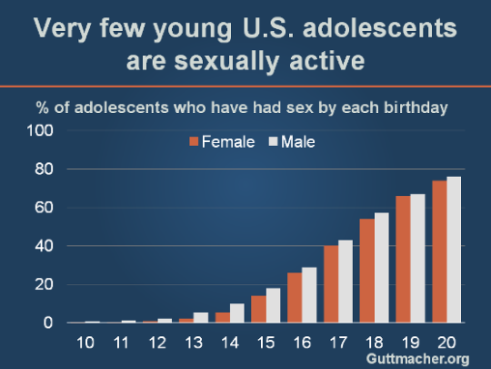Sexual activity is and has long been rare among the youngest adolescents, according to "Sexual Initiation, Contraceptive Use and Pregnancy Among Young Adolescents," by Lawrence B. Finer and Jesse M. Philbin of the Guttmacher Institute, published online in the journal Pediatrics. Very few early adolescents (both boys and girls) have had sex (0.6% of 10-year-olds, 1.1% of 11-year-olds and 2.4% of 12-year-olds), and the incidence of pregnancy among girls aged 12 or younger is minuscule. But adolescence is a time of rapid change, and sexual activity is more common among older teens, including one-third (33%) of those aged 16, nearly half (48%) of those aged 17, and 61% and 71% of 18- and 19-year-olds, respectively.
Moreover, this pattern has prevailed for decades: A low level of sexual activity among young adolescents has long been the norm, while sexual initiation later in adolescence has been and remains a normal part of teens' development process. At the same time, however, recent cohorts have delayed starting sex; in the current cohort of adolescents, the likelihood of sexual activity at any given age is lower than at any time in the past 25 years.
"Policymakers and the media often sensationalize teen sexual behavior, suggesting that adolescents as young as 10 or 11 are increasingly sexually active," says lead author Lawrence Finer. "But the data just don't support that concern. Rather, we are seeing teens waiting longer to have sex, using contraceptives more frequently when they start having sex, and being less likely to become pregnant than their peers of past decades."

Contraceptive use is common among teens. Once they begin to have sex, teens regularly protect themselves and their partners from unintended pregnancies and STDs. The authors found that contraceptive initiation among girls as young as 15 was similar to that of the oldest teens. More than 80% of 16-year-olds used a method at first sex, and by one year following first sex, 95% of those teens had used contraceptives. However, adolescents who initiated sex at 14 or younger were less likely to use contraceptives at first sex and took longer to begin using a method.
Importantly, the analysis also found that sex among very young adolescents is frequently involuntary. Sixty-two percent of females who had had sex by age 10 said that their first sex was coerced, as did 50% of those who had had sex by age 11. The authors argue that coerced sex warrants attention in and of itself.
The authors suggest that pediatricians and adolescent health professionals are in an ideal position to teach adolescents about contraception before they become sexually active, and to make methods available to their patients in advance of first sex, which can help improve teen health outcomes. They are also well placed to screen for unwanted sexual activity among patients of all ages.
To carry out their analysis, the authors used newly available public data on sexual initiation (defined here as vaginal intercourse), contraceptive use and pregnancy among American adolescents aged 10–19 from the 2006–2010 National Survey of Family Growth, conducted by the U.S. National Center for Health Statistics, and other sources.
"Sexual Initiation, Contraceptive Use and Pregnancy Among Young Adolescents," by Lawrence B. Finer and Jesse M. Philbin of the Guttmacher Institute, is currently available online and will appear in the May 2013 issue of Pediatrics. For a full copy of the article, please contact the journal directly.